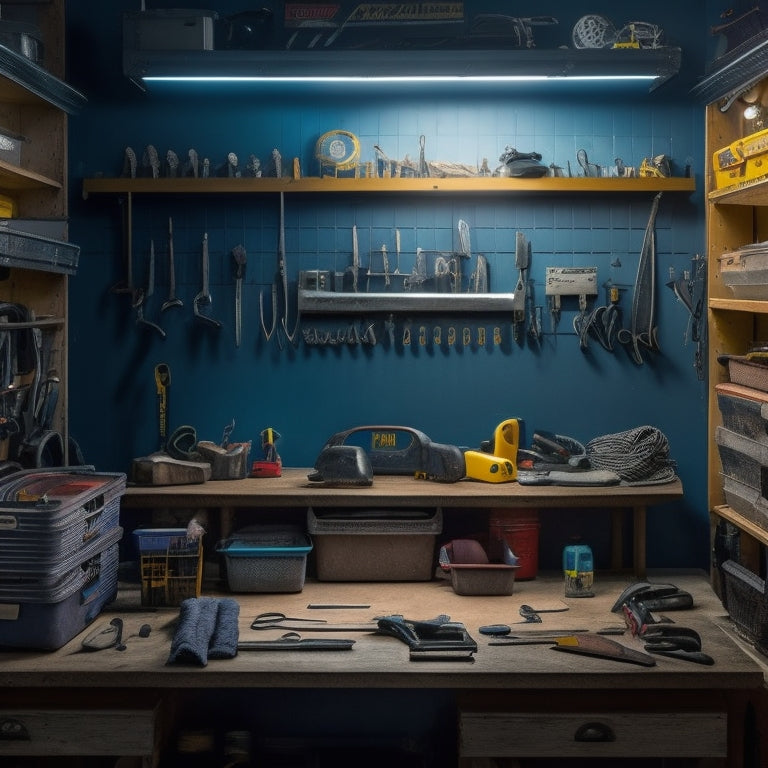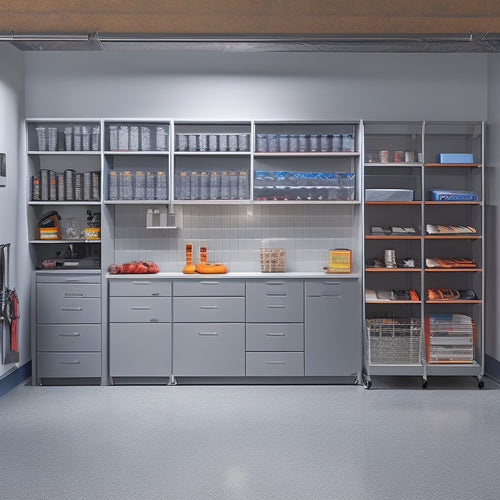
Effortless Tool Organization for Busy Contractors
Share
You're tired of wasting time searching for tools on the job site. To optimize your workflow, start by utilizing compact tool storage solutions that fit your small workspace. Designate a specific tool area and organize tools logically to minimize searching and walking distances. Consider customizable systems with adjustable compartments, labeling, and signage for easy identification. Streamline your tool retrieval process by mapping tool locations and implementing efficient inventory management. By implementing these strategies, you'll be able to find what you need quickly and focus on getting the job done. Now, discover how to tailor your system to your specific trade and workflow.
Key Takeaways
• Utilize portable and compact tool storage solutions with built-in organizers and adjustable dividers to maximize small space efficiency.
• Organize tools logically to minimize searching and walking distances, and designate a specific tool area for storage and maintenance.
• Implement a customizable tool organization system with modular storage options, adaptable shelving configurations, and labeling for easy identification.
• Streamline tool retrieval by mapping tool locations, using digital cataloging, and designing quick access storage areas to reduce downtime and frustration.
• Avoid common tool storage mistakes, such as inadequate storage solutions, failure to categorize and label tools, and cluttered workspaces, to optimize tool organization.
Tool Storage for Small Spaces
When you're working with limited space, optimizing tool storage becomes essential to maintain efficiency and reduce downtime. As a busy contractor, you can't afford to waste time searching for misplaced tools or equipment. Compact solutions and portable options are your best friends in this situation.
Consider investing in toolboxes and chests with built-in organizers, which can help you keep your tools within easy reach. Look for options with adjustable dividers and removable trays to customize your storage setup.
Another space-saving strategy is to make the most of your vertical storage. Install pegboards or hooks on walls or ceilings to hang tools, freeing up floor and shelf space. You can also use stackable storage bins and containers to keep supplies and materials organized.
Maximizing Job Site Efficiency
By streamlining your workflow and eliminating unnecessary steps, you can shave precious minutes off your job site tasks and get more done in less time. A well-organized job site is essential to maximizing productivity and efficiency.
Here are some time-saving strategies to help you get the most out of your workday:
-
Efficient tool arrangement: Organize your tools in a logical and accessible order to reduce walking distances and minimize searching.
-
Designate a tool area: Allocate a specific space for tool storage and maintenance to keep your work area clutter-free.
-
Group similar tasks together: Complete tasks that require similar tools or materials in one session to reduce setup and teardown time.
- Label and mark tools: Clearly label and mark your tools and equipment to guarantee quick identification and accessibility.
Customizable Tool Organization Systems
Now that you've optimized your job site efficiency, it's time to focus on customizable tool organization systems that adapt to your unique needs.
You'll want to evaluate systems that offer modular storage options, allowing you to add or remove components as your toolset evolves.
Modular Storage Options
You can create a customized tool organization system that adapts to your specific needs with modular storage options. These systems are designed to be flexible and adaptable, allowing you to configure them to fit your specific toolset and workflow.
With modular storage options, you can easily add or remove components as your needs change.
Here are some benefits of modular storage options:
-
Portability: Use a portable toolbox to take your tools on the go, and easily transport them from job site to job site.
-
Space-saving: Opt for wall mounted racks to maximize your garage or workshop space, keeping your tools organized and within reach.
-
Customization: Mix and match different components to create a system that fits your unique needs and toolset.
- Scalability: Easily add or remove modules as your tool collection grows or changes, ensuring your system stays organized and efficient.
Adjustable Shelving Configurations
With adaptable shelving configurations, you can create a personalized tool organization system that evolves with your changing needs, allowing you to optimize storage space and access your tools with ease. This customized approach guarantees that your storage solutions adapt to your workflow, making the most of your available space.
Compact storage solutions and space-saving shelves enable you to store more tools in a smaller area, keeping them within easy reach.
Adaptable racks offer versatile organization, allowing you to rearrange your storage layout as needed. You can reconfigure your shelves to accommodate different tool sizes, types, and frequencies of use. This flexibility guarantees that your tool organization system remains efficient and effective, even as your project requirements change.
By optimizing your storage space, you'll reduce clutter, save time, and increase productivity. With adaptable shelving configurations, you can create a tool organization system that works for you, not against you.
Essential Tool Storage Features
Tool storage solutions that effectively organize your equipment must incorporate several essential features to maximize accessibility, visibility, and protection. As a busy contractor, you need a system that helps you quickly find what you need, saves space, and safeguards your valuable tools.
When selecting a tool storage solution, look for the following essential features:
-
Adjustable compartments: Customize storage spaces to fit tools of various sizes, ensuring a snug and secure fit.
-
Robust construction: Strong materials and resilient designs guarantee your storage solution withstands the demands of your workshop or job site.
-
Labeling and signage: Easily identify contents and locations with clear labels and signs, saving you time and frustration.
- Secure mechanisms: Protect your valuable tools and equipment from theft or unauthorized access with reliable locking systems.
Streamlining Tool Retrieval Process
Now that you've got your tools stored, it's time to focus on getting them back out efficiently.
You need a system that saves you time and reduces frustration when you're in the middle of a job.
Tool Location Mapping
You can greatly reduce downtime and frustration by creating a visual map of your tool locations, allowing you to pinpoint exactly where each item is stored. This tool location mapping process is an essential step in streamlining your tool retrieval process.
By having a clear understanding of where your tools are located, you can quickly identify what's missing and what needs to be restocked.
Here are some benefits of tool location mapping:
-
Improved tool tracking: A visual map helps you keep track of your tools, reducing the likelihood of lost or misplaced items.
-
Efficient inventory management: With a clear picture of your tool inventory, you can easily identify what needs to be reordered or replaced.
-
Streamlined tool retrieval: By knowing exactly where each tool is stored, you can quickly retrieve the tools you need, reducing downtime and increasing productivity.
- Enhanced digital tool cataloging: Using barcode scanning and digital tool cataloging, you can create a digital record of your tool inventory, making it easy to track and manage your tools.
Optimize Storage Spaces
Effective storage areas are crucial to streamlining your tool retrieval process, as messy and disordered spaces can result in wasted time and decreased productivity. You need to optimize your storage areas to make certain that your tools are easily accessible and quickly retrievable.
To achieve this, consider implementing space-saving solutions and innovative storage concepts. For example, you can set up shelves, hooks, or bins to maximize your storage capacity. Label each storage compartment so you can swiftly identify where each tool is stored.
Invest in efficient storage solutions that offer compact organization choices. This will aid you in making the most of your accessible space and reducing clutter. Consider using stackable containers, hanging organizers, or modular storage systems that can be tailored to fit your specific requirements.
Quick Access Design
By strategically positioning your most frequently used tools in easy-to-reach locations, you'll shave precious minutes off your workflow and get jobs done faster. This is the essence of quick access design, which is all about streamlining your tool retrieval process.
To achieve this, consider the following strategies:
-
Ergonomic Portable Toolboxes: Invest in portable toolboxes with ergonomic design that allow you to carry your essential tools comfortably, reducing fatigue and increasing productivity.
-
Tool Belts with Magnetic Attachments: Use tool belts with magnetic attachments to keep your frequently used tools within easy reach, freeing up your hands for more important tasks.
-
Designate a 'Hot Zone': Identify a specific area on your work site as a 'hot zone' and store your most frequently used tools there, minimizing travel time and increasing efficiency.
- Label and Sign: Label and sign your tool storage areas and containers, ensuring that you and your team can quickly identify where tools are stored, reducing confusion and saving time.
Common Tool Storage Mistakes
Frequently, contractors overlook the significance of properly storing their tools, leading to cluttered workspaces, wasted time, and even damaged equipment. You're not alone if you've fallen into this trap. But, it's time to recognize that tool organization tips are essential to your success.
One common mistake is using inadequate storage solutions. You might be tempted to stuff your tools into a small box or leave them scattered around the workshop. However, this approach will only lead to more problems. You'll spend hours searching for misplaced tools, and your workspace will remain cluttered.
Another mistake is failing to categorize and label your tools. Without a clear system, you'll struggle to find what you need when you need it. Take the time to organize your tools by type, frequency of use, and project requirements. This simple step will save you time and reduce frustration.
Tool Organization for Specialty Trades
When working in specialty trades like electrical, plumbing, or HVAC, you need a tailored tool organization system that accommodates the unique demands and equipment of your trade. A one-size-fits-all approach won't suffice when you're dealing with specialized tools and materials.
To maximize efficiency and productivity, consider the following strategies:
-
Custom toolboxes: Invest in custom toolboxes that are specifically designed for your trade. This will guarantee that you have a designated place for each tool and can quickly access what you need.
-
Portable racks: Use portable racks to store and transport bulky equipment, such as ladders or generators.
-
Vertical pegboards: Install vertical pegboards in your workshop or truck to hang frequently used tools, keeping them organized and within reach.
- Drawer dividers: Use drawer dividers to separate and categorize your tools, making it simple to find what you need in a hurry.
Frequently Asked Questions
How Do I Prevent Tools From Getting Lost or Stolen on the Job Site?
To prevent tools from getting lost or stolen, you should consider using tracking devices and unique tool markings to identify your equipment.
Can I Use Tool Organization Systems for Non-Traditional Work Vehicles?
You can definitely use tool organization systems for non-traditional work vehicles, as long as you opt for compact solutions that adapt to unconventional applications, offering versatile storage that tackles your unique challenges.
Are There Any Tool Organization Systems Suitable for Extreme Weather Conditions?
"You're not alone in battling the elements! Look for weather-resistant storage solutions and durable equipment that can withstand torrential rains, scorching heat, and freezing temps, ensuring your tools stay protected and ready for action."
How Do I Organize Tools for a Team of Contractors With Different Roles?
You'll want to implement role-specific organization, categorizing tools by job function, and use team tool tracking systems to guarantee each contractor can easily access and return tools, streamlining workflow and reducing downtime.
Can I Customize Tool Organization Systems to Fit My Specific Trade Needs?
You can create customized solutions tailored to your trade specific needs, ensuring a personalized organization that boosts efficiency and job site security, so you can focus on what matters most - getting the job done.
Related Posts
-

Heavy-Duty Pegboard Hooks for Industrial Use
You need heavy-duty pegboard hooks that can withstand the rigors of industrial use, providing a reliable and efficien...
-

Building a Garage Storage System With Built-Ins
You're about to build a garage storage system with built-ins that fits your unique needs, starting by evaluating your...
-

What Tools Do I Need for a DIY Wall Organizer
You'll need a variety of tools to complete a DIY wall organizer project. Essential measuring tools include a tape mea...


